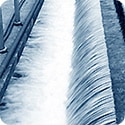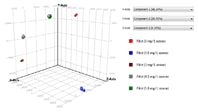Access Agilent eNewsletter October 2015
>> Update My Profile | Subscribe to Access Agilent | Article Directory

Easy screening and exhaustive profiling of
non-targeted water contaminants achieved with Agilent integrated solution
By Sylvain Merel and Shane Snyder
University of Arizona, Tucson, AZ USA
and Craig Marvin
Agilent Global Environmental Industry Manager
Trace levels of unregulated, emerging contaminants in source water supplies [1] and finished drinking water [2] have increased consumer concern about water quality and safety for water utilities are facing both challenges of increasing water shortages and population growth [3]. Supplementing water supplies through water reuse initiatives increases the complexity of monitoring treatment efficiency. This is due to the combined occurrence in wastewater of a large number of potential chemical contaminants along with their metabolites, all of them being precursors of multiple chemically and toxicologically unknown transformation products arising through biological or oxidative treatment [4].
The right tools for the task
Efficient and cost-effective treatments for wastewater reuse require advanced tools to monitor emerging contaminant content and by-product formation. Accurate-mass quadrupole time-of-flight (Q-TOF) spectrometry detects and resolves trace levels of thousands of different organic compounds in water with low part per million accuracy. To illustrate this, we used an Agilent 1290 Infinity II LC system with a ZORBAX Eclipse Plus C-18 column and an Agilent 6540 Q-TOF LC/MS for the analysis of several wastewater samples treated with different ozone doses. Agilent MassHunter software and Agilent Mass Profiler Professional software were used in processing the data.
Figure 1 shows the total ion chromatograms for triplicate injections of wastewater exposed to different levels of ozone. The overlap and compositional differences between the samples can be roughly observed but are too complex for direct interpretation.
 Enlarge
Enlarge
Figure 1. Total ions chromatograms (TICs) for untreated wastewater and wastewater treated with various doses of ozone.
 Enlarge
Enlarge
Figure 2. PCA reveals that samples treated with different doses of ozone can be clearly differentiated. The triplicates in each group also cluster very closely together.
Extract contaminants with comprehensive Agilent software
Agilent MassHunter Workstation software extracts molecular features from each chromatogram (Figure 1) and establishes a detailed profile for each sample. Compound alignment in Agilent Mass Profiler Professional software aligns retention times and accurate mass, therefore removing artifacts due to minor variation inherent to any type of analysis. After filtering out compounds detected in blanks, subsequent analysis revealed 23,574 compounds detected in wastewater samples. Of these, 13,996 compounds were detected at least twice (either in different replicates or in different samples). These were compounds used for recursive analysis to further eliminate any false positives.
Using Agilent MassHunter Qualitative Analysis software for recursive analysis, the chromatograms were examined again for the 13,996 compounds isolated by the initial filtering. Compound-specific searches were performed and 12,889 compounds were identified. These compounds resulting from the recursive analysis were further filtered using Agilent MPP in order to keep only the most statistically relevant (based on p-value and fold change analysis). Therefore, only the compounds that did not appear in blanks (extracted HPLC-grade water) – and were detected in 100% of the triplicate analyses for at least one of the ozone doses – were selected for further analysis. This additional filtering left 9,493 compounds.
Principal component analysis was used in determining samples based on the ozone dose exposure. Figure 2 shows that every ozone level could be distinguished from the others, and the triplicate samples taken at each level clustered closely, indicating excellent reproducibility.
Hierarchical clustering analysis (HCA) was performed to further characterize the effects of ozonation on chemicals present in wastewater. HCA revealed several groups of compounds with differing responses to ozonation. Two groups were removed by ozone, while three others were formed by ozone treatment. Several compounds were resistant to ozone treatment.
Easy identification of compounds
Analysis of variance (ANOVA) was performed with a Tukey’s test to distinguish compounds whose abundance varied significantly between different ozone doses. From the 9,493 compounds identified through recursive analysis, ANOVA identified 8,244 compounds with significant variation of abundance (p <0.05) dependent on the ozone dose. Table 1 summarizes the Tukey’s test comparison of each sample treated by a different ozone dose, indicating the number of compounds that did or did not significantly vary in abundance.
|
|
Ozone dose (ppm) |
|||||
|---|---|---|---|---|---|---|
|
Ozone |
|
0 |
1.5 |
3.0 |
4.5 |
5.6 |
|
0 |
8244 |
4548 |
5524 |
6083 |
6150 |
|
|
1.5 |
3736 |
8244 |
3083 |
4299 |
4843 |
|
|
3.0 |
2720 |
5161 |
8244 |
2476 |
3395 |
|
|
4.5 |
2161 |
3945 |
5768 |
8244 |
2226 |
|
|
5.6 |
2094 |
3401 |
4849 |
6018 |
8244 |
|
Compounds that vary in abundance
Compounds that do not vary in abundance
Comparison of one sample group to itself
Table 1. Number of compounds that vary in abundance with ozone dose (ANOVA with p <0.05).
Routine ‘targeted’ analysis of wastewater does not fully identify the large number of compounds present. Nontargeted screening of water samples using Agilent MassHunter software, and Agilent 6500 Series Accurate-Mass (Q-TOF) LC/MS provides a sensitive solution for monitoring changes in water quality that occur during water treatment. To learn more about nontargeted screening of emerging detection in environmental water, read Agilent publication 5991-4417EN.
Agilent offers a wide range of solutions for testing contaminants in water
In addition to LC/Q-TOF, Agilent has developed sample preparation and automation solutions to increase efficiency and sensitivity when analyzing emerging contaminants in water. For example, the Agilent 1200 Infinity Series Online SPE solution (FlexCube) enables the enrichment of analytes and removal of matrix elements in a process that delivers low detection limits and high throughput.
The SPE platform is comprised of the Agilent 6460 Triple Quadrupole LC/MS, MassHunter software, HPLC columns, and our solid phase extraction cartridges which can be reused for multiple samples. This integrated solution allows small sample sizes (<2 mL) to be tested in a fast and cost-effective process that enables high-performance separation of emerging contaminants. Contact an Agilent Representative today to find out more about these sensitive, time-saving solutions.
References
- Kolpin, D. W. et al. Pharmaceuticals, hormones, and other organic waste contaminants in U.S. streams, 1999-2000: a national reconnaissance. Environ. Sci. Technol. 2002, 36, 1202-1211 (2002).
- Benotti, M. et al. Pharmaceuticals and endocrine disrupting compounds in U.S. drinking waters. Environ. Sci. Technol. 2009, 43, 597-603.
- Arnold, R. G. et al. Direct potable reuse of reclaimed wastewater: it is time for a rational discussion. Rev. Environ. Health 2012, 27, 197-206.
- Anon. Water Reuse: Potential for Expanding the Nation’s Water Supply Through Reuse of Municipal Wastewater; National Research Council of the National Academies, The National Academies Press Washington, DC. 2012.
>> Update My Profile | Subscribe to Access Agilent | Article Directory

